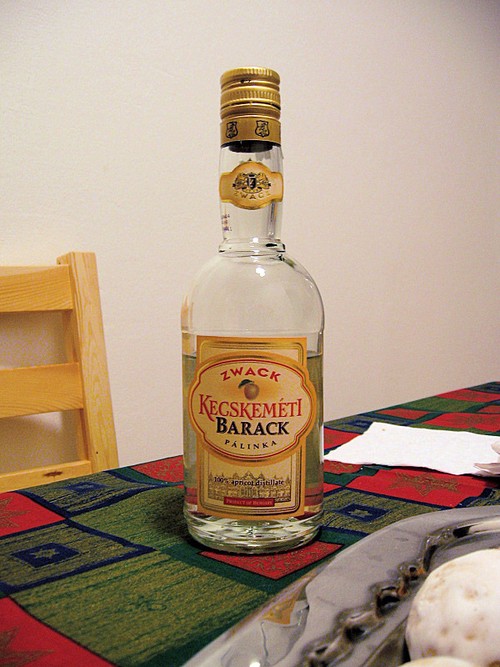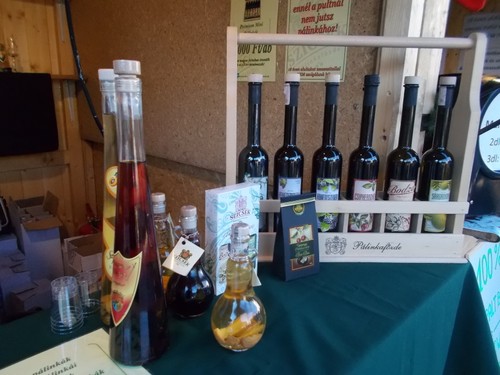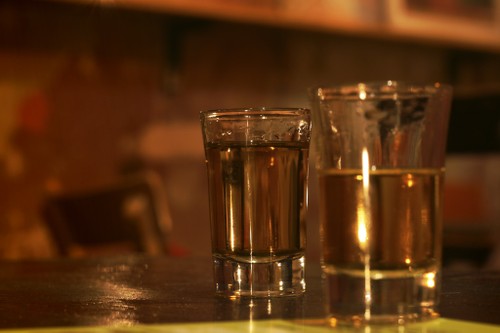As an old Hungarian saying goes, “What you can use for making jam, you can also use for making pálinka”. With an estimated 100 different types of pálinka across Hungary, this satisfying drink can be distilled from almost any imaginable fruit found in the Carpathian Basin. This variety, however, does not mean the name “pálinka” can be used for any fruit spirit. To be qualified as pálinka, the spirit must meet all the requirements of the 2008 “Palinka Law”. Szabados Bálint who lives in Budapest, Hungary elaborates:
“Pálinka needs to have 100% fruit content, containing no additives, which means no sugar or artificial flavorings can be added. It must be made from fruit grown in Hungary and has to be prepared here as well. Outside the country, only four Austrian provinces have the legal right to produce it and call it pálinka, according to EU law. The alcohol content must be at least 37.5%. For homemade pálinka, it can get as high as 80%.”
 A bottle of pálinka, a typical Hungarian drink (Photo: Guus Bosman/Wikimedia Commons) A bottle of pálinka, a typical Hungarian drink (Photo: Guus Bosman/Wikimedia Commons) |
If you come to Hungary, chances are you will stumble upon pálinka very quickly. The fruit spirit, with its high alcohol level, acts as a mood-booster on several occasions: Before hitting the club, during birthday parties, and most commonly, at family gatherings. Like other ‘hungaricums’– a title given only to the finest Hungarian products – pálinka has a long history that dates back to medieval times. Szabados continued.
“Pálinka is definitely the go‑to greeting drink in Hungary. It’s a very popular welcoming drink in Hungary, especially when you attend a family gathering or get invited over for a Sunday lunch. It’s common for a guest to be immediately offered pálinka by the host. I think it’s fair to say any Hungarian who doesn’t avoid alcohol completely has tried pálinka at least once.
The word “pálinka” originates from the Slavic word “pálit”, which means to distill. Spirits arrived in Hungary through foreign countries and were used as medicine in the royal palaces in the 14th century. The first written record of pálinka was found in Debrecen, Hungary and dates from 1572.”
 Different flavours of pálinka at a Christmas market in Budapest (Photo: Globetrotter19/Wikimedia Commons) Different flavours of pálinka at a Christmas market in Budapest (Photo: Globetrotter19/Wikimedia Commons) |
Once a medicine in royal courts, pálinka nowadays is still widely used by Hungarians for its healing properties. Many believe that a sip of the good old fruit brandy can combat common illnesses, especially during the harsh winter times.
“It is believed that pálinka is a digestive aid, a remedy for colds, an antiseptic, and provides relief from toothache, sore throat or stomach ache. Palinka, with its strong taste, certainly feels like medicine when you’re feeling under the weather. I would say it definitely helps a little when you have a common cold.”
With such a high level of alcohol, pálinka is definitely not for the fainthearted. Many first-time drinkers make the mistake of downing a full pálinka shot in one go, leaving only a burning sensation that numbs every sense in their body. To fully experience the refined fragrance of this hard liquor, Szabados recommends starting with small sips.
“For some, Pálinka can be difficult to drink due to its high alcohol percentage. It’s especially intimidating when a Hungarian offers you pálinka for the first time and they fill a shot glass almost to the brim. My advice is to start small. If you can tolerate the strong alcoholic taste, there are many pálinka flavors you can enjoy, for example: pear, plum, cherry and quince. My favorite flavor that I have tried so far was homemade elderberry. Elderberry is the taste of summer for me, and in pálinka it has a citric taste to it that is very distinct. I recommend pear pálinka. Similarly to apricot, it has a more up‑front fruity, savory taste, while it doesn’t burn your throat as much compared to other flavors.”
The taste of Palinka depends on the fruit, the soil, and the climate. Hence, it is difficult to find identical batches of the drink, for every variable yields a slightly different result. Traditionally, pálinka is served in tulip-shaped glasses allowing the multilayered flavors to bloom. Nevertheless, in ruin pubs or other casual settings, Szabados said the simple, old shot glasses are now a popular choice.
 Pálinka is commonly served in shot glasses (Photo: Savagecat/Flickr) Pálinka is commonly served in shot glasses (Photo: Savagecat/Flickr)
|
“Occasionally, Hungarians will drink from special tulip glasses, whose distinctive shape serves to intensify the aroma and flavor. Travel guides will have you believe that this is how we regularly enjoy pálinka, but it is far more common for us to bring out the well-worn shot glasses to share among friends.For those looking for an alternative to small shots, there are plenty of cocktail variations that use pálinka.”
With an unassuming appearance, yet a strong and complex aftertaste, pálinka captures the very core of the Hungarian identity. Even though centuries have passed, the tradition of drinking pálinka is still ubiquitous in Hungary, and leaves an unforgettable impression on every tourist coming to this beautiful land.